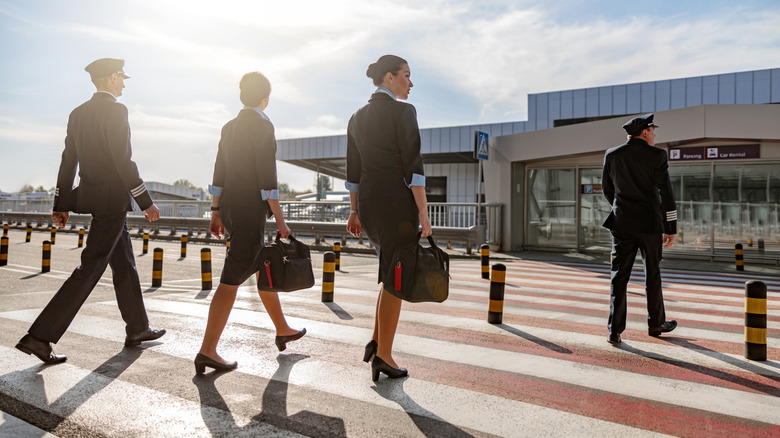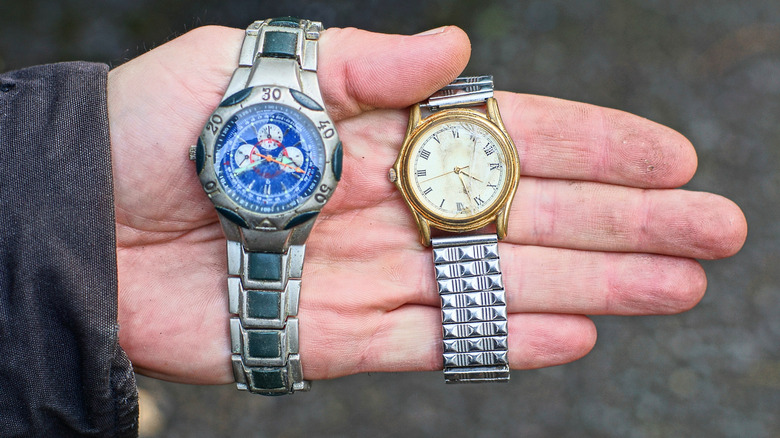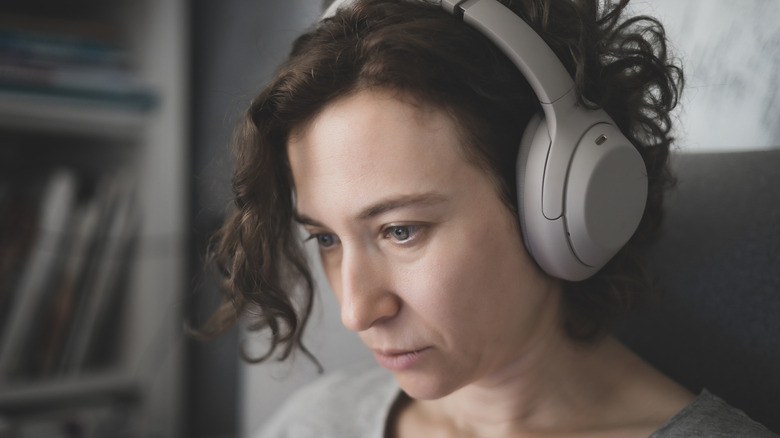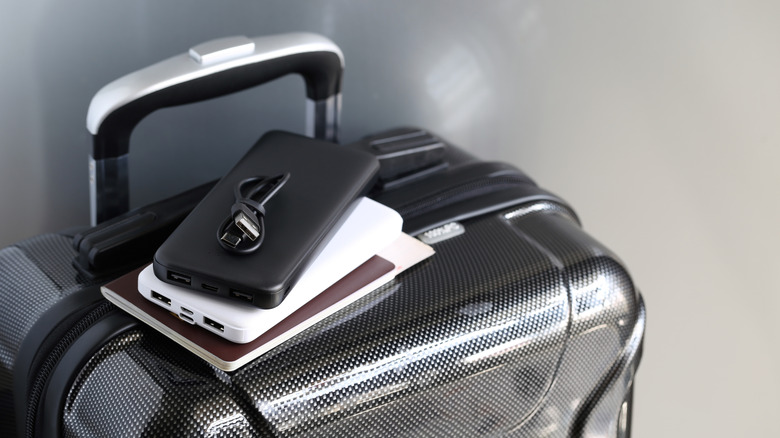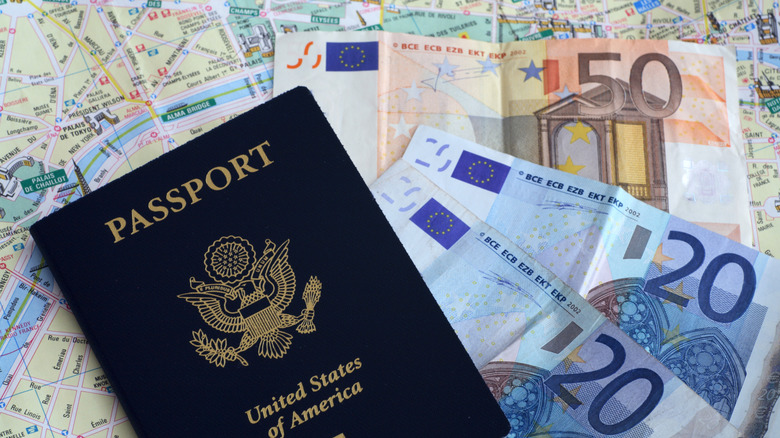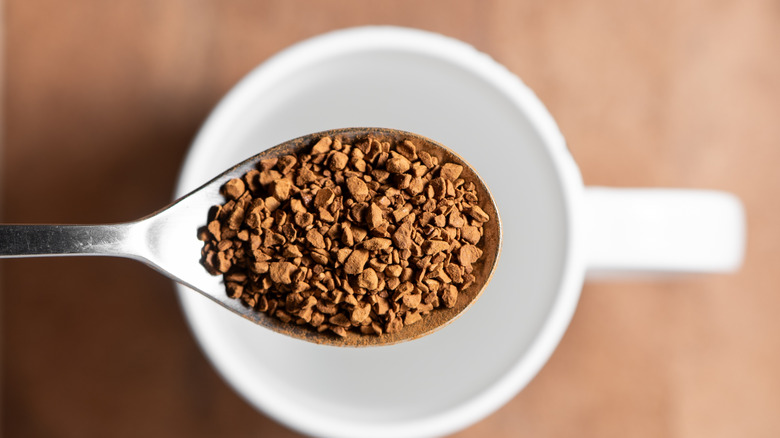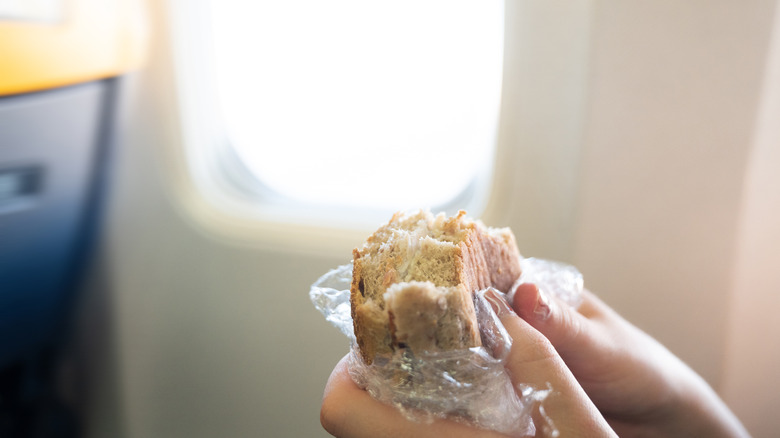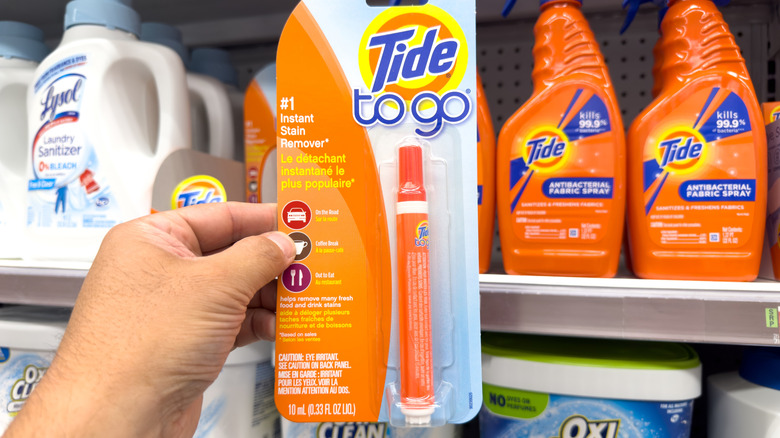11 Items Flight Attendants Never Forget To Pack In Their Carry-On
Flight attendants seem to have it all going for them. These chirpy air stewards showcase a perennial smile and are frequently there to help you with anything you might need while onboard their airplane. They spend their days moving about the country (and sometimes the world), stopping for layovers in small towns and big urban oases. Flight staff have some major perks, for sure, but they also have to maintain that cheery demeanor through long hours on their feet and manage often-demanding clients who can become irate at even the slightest delays.
Flight attendants, therefore, have to think far in advance when planning their carry-on bags. The items they bring for the journey aren't part of a holiday kit but a workplace toolbox that will get them through whatever a tough day in the sky might throw their way. These airline workers quickly learn what works for them and what doesn't, and carry-on packing lists tend to feature a condensing effect. Small, value-adding inclusions make the cut, while bulkier items are left at home unless necessary. These are some of the key features that always make their way into the bags of flight attendants before they head to the airport for a day of travel. You might find some items valuable enough to adopt them for your journeys.
Their safety manual
Cabin crew members aren't just employees working solely in the service industry. For instance, flight attendants are observant individuals who analyze passengers as they board an aircraft. They play a critical role in maintaining order and safety aboard the plane throughout its journey. Their role includes helping get people to their seats, assisting the flight crew when necessary, and delivering service elements that make passengers more comfortable.
Beyond the obvious, flight attendants are also tasked with all kinds of responsibilities regarding emergency aircraft situations and more. Because these staff members operate in so many different spheres, they must keep their safety manual on hand at all times. All kinds of wacky and strange occurrences can happen on an airplane, and the flight crew needs to be prepared to deal with anything that may come up in the air. Keeping their safety manual nearby is the best way to do this. Both as a practical matter and a flight requirement, flight attendants won't quickly forget to pack their safety manual when preparing for a day of travel.
A spare watch
In the same way that flight attendants' safety manuals need to stay with them, so does one particular piece of equipment. Flight crew members are required to wear a watch while on duty. This is an important tool for all kinds of flight management needs, but it's particularly valuable during an emergency for keeping track of time, which can be crucial.
Keeping a watch on their wrists is just a part of the job, but all manner of circumstances can collide to throw a wrench in these plans. Watches can break, and forgetting belongings at home or in a hotel room is also entirely possible, especially at the worst possible times. All these reasons combined to make a backup watch something that flight attendants frequently won't take their jump seat without. If a backup is needed, most flight attendants would rather use a secondary watch they own or settle for whatever they can find in an airport gift shop or elsewhere. This gives them an important fallback for greater comfort.
Noise canceling headphones
It is no secret that travelers frequently want to tune out the world and relax while on the move. Flight attendants experience the same desires and often rely on the same tools as their traveling companions when they get an opportunity to sit down and recharge. During breaks in their shift, flight attendants frequently pull out a set of noise-canceling headphones to help them unwind. These entertainment tools have become a mainstay in the world of travel and can help tune out the engine noise to improve the taste of your airplane food! With this in mind, noise-canceling headphones should be on your packing list if they are not already.
Switching on active noise cancelation helps users block out sounds around them, focusing solely on whatever they're listening to. For some, this might be white noise to help promote sleep, and other flight attendants might relax with the help of an episode of their favorite show or a few good tunes. Modern headphones are fairly compact, deliver great battery life in most instances, and are, overall, easy to slip into a carry-on bag. This is a no-brainer for flight attendants looking for a support system to help unplug when lying down in the secret cabin of a long-haul flight or relaxing for a few minutes in the back between services.
A charging adapter or power bank
Naturally, charging gear is a prominent feature on any packing list. Passengers and flight attendants will be quick to add a power bank or adapter to support charging on the go to their carry-on bag. This equipment is generally small in stature and easy to pack away. But no matter the preference in charging gear, these features play a huge role in the continued comfort, entertainment, and connectivity of flight attendants as they traverse the world.
In terms of power banks, a variety of types and sizes are available, so those looking to emulate the travel strategies of a flight attendant have a few choices to make. The typical smartphone battery today features roughly a 2,500 to 4,000 mAh capacity. This means a power bank with the same specification can deliver a single, full charge to your phone when packed away at full battery capacity. Much larger options are available, and you might want to consider those for your road-tripping packing list or long-haul flights with layovers.
On the other hand, frequent international travelers will likely want to pack a charging adapter instead or in addition to a power bank. An adapter allows you to plug your phone into the wall, regardless of where you might find yourself in the world. Many adapter kits feature a condensed footprint with a full slate of interchangeable pins.
A moisturizing cream
The sky is quite an unfriendly place for your skin, and you need all the tips you can get from frequent travelers. For instance, Tan France recommends tons of genius packing hacks for flying to help make your travel experience less daunting. This includes bringing along a moisturizer. Flight attendants seem to be in agreement with this approach, and most will pack some sort of moisturizing cream in their carry-on no matter how far their day in the sky will take them. The high altitude and cold air combine to dry out the face significantly. With flight attendants constantly spending hours at a time up in this part of the atmosphere, they are in particular need of a skin defense strategy.
France suggests that travelers apply a thick layer of moisturizing cream to their face and leave it there while traversing the skies. Flight attendants don't have this option but can remoisturize their faces while taking a break or between flights. Cabin crew members typically do just that to protect their skin from the constant atmospheric changes during a typical workday, between each takeoff and landing.
It's worth noting that flight attendants and regular travelers have slightly different restrictions and rules when it comes to carry-on baggage. If you are looking to emulate the flight attendant's packing list for effortless travel, make sure the moisturizing cream in your carry-on does not exceed the 3.4-ounce liquid limit. Yes, TSA considers lotions liquids.
Their passports and a small amount of foreign cash
Bringing your passport when traveling is a given when your itinerary takes you out of the country. You likely can't make it to the gate, or at the very least, get on the plane on an international route without showing your passport to airport security or airline staff. Flight staff experience a slightly different norm when it comes to getting onto the aircraft, though. This difference in routine means that flight attendants have to think about their travel documents in a unique way.
Flight schedules can change abruptly, and flight attendants can see their day take them to just about any destination imaginable. As a result, cabin crew members always pack their passports in case they need them. A routine traveler isn't likely to suddenly find themselves jetting off to a foreign country, but flight attendants have this happen to them far more often than you might expect.
Similarly, a flight attendant might start the day expecting to work a specific schedule only to have a layover drag out or flight plans change for upcoming shifts. This can mean that flight attendants may stay on the road between shifts rather than return home. As a complement to this important travel document, many flight attendants will carry at least a few foreign currencies. The last thing a flight attendant will want to do is get stuck in England, Belgium, or Mexico for a few days without easy access to local cash resources.
Extra clothing (particularly socks and underwear)
As we have discussed, the realities of travel as a flight attendant can be demanding as it features a fast-schedule evolution and short-term needs. A single flight on a short hop can sometimes turn into multiple days away from home. For this reason, extra clothing items are critically important in flight attendants' carry-on luggage. It also adds another element to the packing list that most travelers won't need to think about. It's a good idea to pack at least a single change of clothes in your carry-on bag. In the event that your checked luggage gets lost along the way, you can slip into something comfortable while looking for a solution.
Flight attendants, though, have to think a little further ahead. With the threat of an unexpected layover in an unfamiliar place always lurking in the background, they often pack additional clothing in their carry-on, even if they only anticipate working for a single day before heading back home. Extra socks and underwear are particularly important items on this packing list of extenuating circumstances. These clothing items are lightweight and small, meaning a flight attendant can pack a few changes of these critical items without changing their bag.
Instant coffee
A bag of instant coffee can go a very long way. For those uninitiated to this caffeine delivery system, instant coffee doesn't require the bulky setup that transforming beans into a cup of Joe demands. The only thing required here is a cup of hot water (or warm, if that's your preference). Fortunately for flight attendants, this is something found easily on an airplane. With a small bag of instant coffee on hand, flight attendants can make themselves a cup of coffee no matter where they might be.
This is particularly handy for early starts or late-night red-eye flights. Staying alert when everything about your circumstances indicates you should be resting is a challenge flight attendants frequently have to overcome. Instead of pouring a travel mug of hot coffee and lugging it through the airport, instant coffee can be a flight attendant's best friend when tiredness begins to set in.
Instant coffee comes in individual packets, as well. Therefore, travelers looking to adopt this strategy won't have to find a full container of instant coffee. Just seek a travel-sized option that won't take up much space in your carry-on. Additionally, buying individual packets helps you to watch your caffeine intake and only use what you need.
Snacks or even a full, portable meal
During a day of travel, finding time to eat can be challenging, even for a passenger. Airport options aren't always to your liking, and flight itineraries can make sitting down for a meal tough. These limitations are abundant for flight attendants who are constantly working in some capacity throughout their day in airports and on planes. Because it can be a challenge to find time for a meal, flight attendants often bring food with them to shorten the activity and squeeze it into their busy day a little better.
High-protein snacks are a common food item in the carry-on luggage of flight crew. Power bars and ready-to-eat meals are typical inclusions here. Chocolate, nuts, and granola bars are also solid options. Flight attendants sometimes have to prioritize sustenance over flavor, so they typically opt for the highest-value selections available. Getting a boost of energy and satisfying cravings are incredibly important for flight attendants as they routinely run up and down the aisles to serve others for hours at a time, all with a smile on their faces.
Tide pens and laundry detergent powder
Laundry detergent powder and Tide Pens offer an efficient solution to another problem that they frequently face. Tackling stains is a big deal for flight attendants. The rigors of this work can introduce all kinds of dirtying and staining to the clothes that flight attendants wear. The tight spaces they operate within make dropping food and drink items a definite rather than a worst-case scenario.
Every flight attendant on every airline will surely have had to deal with a stained shirt at one time or another. Keeping the uniform clean and tidy is a part of the job, so it's important for a flight attendant to quickly clean up spills that stain clothing. In these circumstances, there's nothing better than the Tide Pen. Many flight attendants carry these wherever they go and use them often.
Another item on the packing list that most flight attendants won't leave home without is a small bag of laundry detergent powder. When checking into a hotel for the night in a new city, many flight attendants will arrive late and leave early in the morning to start their next shift. This means they won't typically have enough time to use the laundry services available at the hotel. Instead, hot water and laundry detergent can be used in a pinch to clean sweaty or dirty clothing, and the room's air dryer can facilitate drying for a tight turnaround.
Disinfectant wipes
Another cleaning solution that flight attendants won't get on a plane without delivers on a wide variety of uses. Disinfectant wipes are good for cleaning everything from airplane tray tables and seats to hotel amenities and rental car surfaces. Flight attendants need to be at their best no matter what. However, the wide range of stressors they subject themselves to on a regular basis can create a scenario in which it's exceedingly difficult to do just that. Performing at your best isn't only about getting enough sleep and eating healthy.
If you're a frequent flier, you might expose yourself — on some level — to all the potential health risks flight attendants encounter daily. This might explain why you might feel under the weather after a flight. The solution here would be to take another leaf from their book. As a defense against this reality, flight attendants often carry disinfectant wipes to quickly wipe down surfaces they'll encounter while out and about. This helps keep them healthier and is a simple solution that doesn't take much time or cost a lot to utilize.
